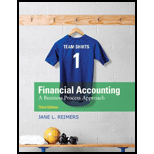
Financial Accounting
3rd Edition
ISBN: 9780133791129
Author: Jane L. Reimers
Publisher: Pearson Higher Ed
expand_more
expand_more
format_list_bulleted
Concept explainers
Question
Chapter 4, Problem 27EA
1.
To determine
Record the transactions into
2.
To determine
Determine the amount that will be shown on the year-end income statement for bad debts expense.
3.
To determine
Determine the balance in the allowance uncollectible account after adjustment.
Expert Solution & Answer
Want to see the full answer?
Check out a sample textbook solution
Students have asked these similar questions
Solve this cogs problem..
Help this answer?
Bistro Brands had the following information:
Total market value of the company's stock: $780
million
Total market value of the company's debt: $220
million
What is the weighted average of the company's debt?
A. 22.00%
B. 28.20%
C. 35.80%
D. 78.00%
E. 90.00%
Chapter 4 Solutions
Financial Accounting
Ch. 4 - Prob. 1YTCh. 4 - Prob. 2YTCh. 4 - Suppose at the end of the year Pendleton Corp.s...Ch. 4 - Prob. 4YTCh. 4 - Prob. 5YTCh. 4 - Prob. 6YTCh. 4 - Prob. 7YTCh. 4 - Prob. 1QCh. 4 - Prob. 2QCh. 4 - Prob. 3Q
Ch. 4 - Prob. 4QCh. 4 - What does true cash balance refer to?Ch. 4 - Identify and explain the financial statements on...Ch. 4 - Describe how accounts receivable arise. What does...Ch. 4 - Prob. 8QCh. 4 - Define net realizable value, book value, and...Ch. 4 - Explain the difference between the direct...Ch. 4 - If a company uses the allowance method of...Ch. 4 - Describe the two allowance methods used to...Ch. 4 - Which method of calculating the allowance for...Ch. 4 - Which method of calculating the allowance for...Ch. 4 - What are the advantages and disadvantages of...Ch. 4 - What is the difference between accounts receivable...Ch. 4 - What is the formula to calculate the accounts...Ch. 4 - How does a firm use its accounts receivable...Ch. 4 - Prob. 19QCh. 4 - Prob. 20QCh. 4 - Prob. 1MCQCh. 4 - Prob. 2MCQCh. 4 - Prob. 3MCQCh. 4 - Prob. 4MCQCh. 4 - Prob. 5MCQCh. 4 - Prob. 6MCQCh. 4 - Prob. 7MCQCh. 4 - Prob. 8MCQCh. 4 - Prob. 9MCQCh. 4 - Prob. 1SEACh. 4 - Prob. 2SEACh. 4 - Prob. 3SEACh. 4 - Prob. 4SEACh. 4 - Prob. 5SEACh. 4 - Prob. 6SEACh. 4 - Prob. 7SEACh. 4 - Prob. 8SEACh. 4 - Prob. 9SEACh. 4 - Prob. 10SEBCh. 4 - Prob. 11SEBCh. 4 - Prob. 12SEBCh. 4 - Prob. 13SEBCh. 4 - Prob. 14SEBCh. 4 - Prob. 15SEBCh. 4 - Prob. 16SEBCh. 4 - Prob. 17SEBCh. 4 - Prob. 18SEBCh. 4 - Prob. 19EACh. 4 - Prob. 20EACh. 4 - Prob. 21EACh. 4 - Prob. 22EACh. 4 - Prob. 23EACh. 4 - Prob. 24EACh. 4 - Prob. 25EACh. 4 - Prob. 26EACh. 4 - Prob. 27EACh. 4 - Prob. 28EACh. 4 - Prob. 29EACh. 4 - Prob. 30EACh. 4 - Prob. 31EACh. 4 - Prob. 32EBCh. 4 - Prob. 33EBCh. 4 - Prob. 34EBCh. 4 - Prob. 35EBCh. 4 - Prob. 36EBCh. 4 - Prob. 37EBCh. 4 - Prob. 38EBCh. 4 - Prob. 39EBCh. 4 - Prob. 40EBCh. 4 - Prob. 41EBCh. 4 - Prob. 42EBCh. 4 - Prob. 43EBCh. 4 - Prob. 44EBCh. 4 - Prob. 45PACh. 4 - Prob. 46PACh. 4 - Prob. 47PACh. 4 - Prob. 48PACh. 4 - Prob. 49PACh. 4 - Prob. 50PACh. 4 - Prob. 51PACh. 4 - Prob. 52PACh. 4 - Prob. 53PBCh. 4 - Prob. 54PBCh. 4 - Prob. 55PBCh. 4 - Prob. 56PBCh. 4 - Prob. 57PBCh. 4 - Prob. 58PBCh. 4 - Prob. 59PBCh. 4 - Prob. 60PBCh. 4 - Prob. 1FSACh. 4 - Prob. 2FSACh. 4 - The following information has been adapted from...Ch. 4 - Prob. 1CTPCh. 4 - Prob. 2CTPCh. 4 - The information given here was taken from Yahoo!...Ch. 4 - Prob. 1IECh. 4 - Prob. 2IECh. 4 - The information given here was taken from Yahoo!...
Knowledge Booster
Learn more about
Need a deep-dive on the concept behind this application? Look no further. Learn more about this topic, accounting and related others by exploring similar questions and additional content below.Similar questions
- A warehouse fire on September 25 destroyed all inventory. The company retrieved the following information: Beginning Inventory (Jan. 1): $220,000 • Net Purchases (Jan. 1 - Sept. 25): $1,750,000 • Net Sales (Jan. 1 - Sept. 25): $3,000,000 • Estimated Gross Profit Rate: 38%arrow_forwardlabor price variance?arrow_forward??!arrow_forward
- A company has the following financial data: Operating income: $400,000 • Average operating assets: $2,000,000 • Minimum required rate of return: 12% What is the company's residual income?arrow_forwardHi expert please give me answer general accounting questionarrow_forwardHow many times per year does the company reorder of this financial accounting question?arrow_forward
arrow_back_ios
SEE MORE QUESTIONS
arrow_forward_ios
Recommended textbooks for you
 Cornerstones of Financial AccountingAccountingISBN:9781337690881Author:Jay Rich, Jeff JonesPublisher:Cengage Learning
Cornerstones of Financial AccountingAccountingISBN:9781337690881Author:Jay Rich, Jeff JonesPublisher:Cengage Learning College Accounting, Chapters 1-27AccountingISBN:9781337794756Author:HEINTZ, James A.Publisher:Cengage Learning,
College Accounting, Chapters 1-27AccountingISBN:9781337794756Author:HEINTZ, James A.Publisher:Cengage Learning,- Principles of Accounting Volume 1AccountingISBN:9781947172685Author:OpenStaxPublisher:OpenStax College


Cornerstones of Financial Accounting
Accounting
ISBN:9781337690881
Author:Jay Rich, Jeff Jones
Publisher:Cengage Learning

College Accounting, Chapters 1-27
Accounting
ISBN:9781337794756
Author:HEINTZ, James A.
Publisher:Cengage Learning,

Principles of Accounting Volume 1
Accounting
ISBN:9781947172685
Author:OpenStax
Publisher:OpenStax College
Accounts Receivable and Accounts Payable; Author: The Finance Storyteller;https://www.youtube.com/watch?v=x_aUWbQa878;License: Standard Youtube License